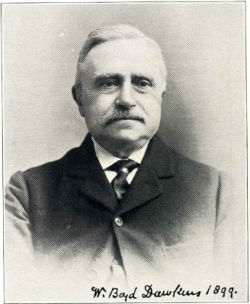William Boyd Dawkins
Contents
Notes
Office Notes
ESL Council 1869-70 Member
AI Council 1871 Member
AI Council 1873 Member
AI Council 1874 Member
AI Council 1877 Member
AI Council 1878 Member
AI Council 1879 Member
AI Council 1880 Member
AI Council 1881 Member
AI Council 1882 Member
AI Council 1883 Member
House Notes
Prof of Geology and Palaeontology in Victoria University, Owen's College, Manchester
1869 Sectional Secretary for Archaeology
member of Settle cave exploration committee
1910 HML The arrival of man in Britain in the Pleistocene age Delivered 22nd Nov.
death noted in the Report of the Council for 1929
Notes From Elsewhere
Professor Sir William Boyd Dawkins, FRS, KBE (26 December 1837 – 15 January 1929) was a British geologist and archaeologist. He was a member of the Geological Survey of Great Britain, Curator of the Manchester Museum and Professor of Geology at Owens College, Manchester.[1] He is noted for his research on fossils and the antiquity of man. He was involved in many projects including a tunnel under the Humber, a Channel Tunnel attempt and the proving of coal under Kent.
Member of the Athenaeum Club from 1894
Born Buttington near Welshpool; died Bowdon, Lancs. Geological Survey of Great Britain 1861-9. Professor of Geology & Palaeontology, Victoria University, Manchester 1874-1908. From 1870s onwards much involved in applied geology. Knighted 1919. Honorary degree from Manchester.
Publications
External Publications
Dawkins published many books and papers, but the best-known are:
· 1866–1939, 1962: British Pleistocene Mammalia. 6 vols. London: Printed for the Palaeontographical Society (co-author with W. Ayshford Sanford, S. H. Reynolds)· [3]
· 1874: Cave Hunting. London: Macmillan
· 1875: "The mammalia found at Windy Knoll", in: Quarterly Journal of the Geological Society; 31, pp. 246–55
· 1877: "The exploration of the ossiferous deposits at Windy Knoll, Castleton, Derbyshire", in: Quarterly Journal of the Royal Society of London; 33, pp. 724–29 (with R. Pennington)
· 1877: · · · "On the Mammal-fauna of the Caves of Creswell Crags"., in: Quarterly Journal of the Geological Society; 33, pp. 589–612
· 1879: "Further discoveries in the Creswell Crags", in: Quarterly Journal of the Geological Society; 35, pp. 724–35 (with J. M. Mello)
· 1880: Early Man in Britain and His Place in the Tertiary Period. London: Macmillan
House Publications
Cresswell Crags JAI vi 95
On the discovery of flint and chert under a submerged forest in West Somerset JES NS ii 141-145
On the discovery of platycnmeic men in Denbighshire JES NS ii 440-468
On the evidence afforded by the caves of Great Britain as to the antiquity of man JAI vii 151-162, 174-185
Questions relating to the mammalia, the vegetation and the remains of ancient races JAI ii 298
Report on the results obtained by the Settle cave exploration committee JAI v 2-5
On traces of man in the Robin Hood cave JAI vi 95
Arrival of man in Britain in pleistocene age [Huxley Lecture] 1910
Related Material Details
RAI Material
Other Material
papers at Rylands library
1868-1931: archaeological and palaeontological corresp and papers
Buxton Museum and Art Gallery
1850-1929: corresp and papers
Manchester University: University of Manchester Library
c1859: exploration diary of Wookey Hole and notes rel to quaternary palaeontology
Wells and Mendip Museum
c1860-69: speleological papers
Oxford University: Museum of Natural History
1880-85: misc papers (7 items)
Somerset Heritage Centre (South West Heritage Trust)
1880-1917: misc corresp
Oxford University: Bodleian Library, Special Collections
1893-1924: letters to Arthur Bulleid
Somerset Heritage Centre (South West Heritage Trust)
1866-92: letters (252) from EA Freeman
Oxford University: Jesus College
1859-71: letters (c100) from JA Green
Oxford University: Jesus College
corresp with James Parker
Oxford University: Museum of Natural History
1861-71: letters (42) to John Phillips
Oxford University: Museum of Natural History
1886-98: letters to AHLF Pitt-Rivers
Salisbury and South Wiltshire Museum
1924-32: letters (64) mainly to Lady Dawkins from AH Sayce
Oxford University: Queen's College Library
